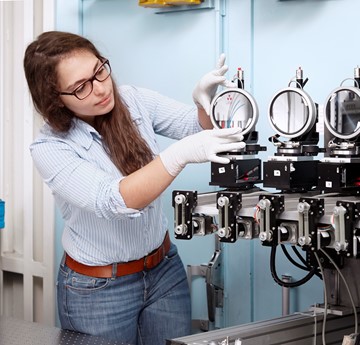Caroline achieved her PhD in 2017, working between Swansea University's Centre for Nanohealth (CNH) and Grenoble Alpes University in France, one of Swansea’s key strategic partners. Her thesis was entitled ‘The role of Selenium in Articular Cartilage Metabolism, Growth and Maturation’.
Caroline, originally from France, was the first person to complete a joint PhD between Swansea and Grenoble universities and went on to win the L’Oreal-UNESCO Women in Science award which recognises the achievements of exceptional female scientists across the globe and awards them with fellowships to help further their research.
Working jointly with Swansea’s Centre for Nanohealth, ISTerre Laboratory (Geochemistry institute) and STROBE laboratory, Grenoble’s world-leading synchrotron facility, Caroline’s research covers a diverse multidisciplinary area, interfacing geology, biology, biophysics, spectroscopy and imaging to analyse the importance of selenium in cartilage health.
Explaining her research, Caroline said: “Selenium is a trace element which is unevenly distributed at the Earth’s surface, and is something a billion people worldwide are deficient in. In China, geological and epidemiological studies present some strong correlations between selenium deficient soils and the endemic disease called Kashin-Beck, a disease characterised by severe growth retardation and joint misdevelopment.”
The results of Caroline’s work will have consequences beyond China as selenium-poor diets effect the long-term health of millions of people worldwide and increase their risk of developing chronic diseases. Caroline said: “I have been using a model of articular cartilage maturation that has allowed me to understand the role of selenium during this vital stage of growth, when the effects of Kashin-Beck are first revealed.”
Caroline has conducted post-doctoral research between French public research organisation, INSERM and the CNH at Swansea University on the role of selenium nanoparticles to dampen the metastatic potential of aggressive cancers such as ovarian and prostate cancers.
She said: “Selenium nanoparticles (Se-NPs) have been attracting a lot of attention due to their high bioavailability, low toxicity and novel therapeutic properties compared to other organic (or not) selenium species. Despite the Se-NPs field receive increasing attention, very little is known about the mechanism by which they exert their anti-metastatic activity (that is, their ability to stop the spread of a disease). Key elements are needed and will be identified to understand how Se-NPs can prevent cancer cell migration and follow their biotransformation once incorporated within the cells using synchrotron X-ray spectroscopic methods.”
Currently, Caroline is finishing a postdoctoral position at the CEA-Grenoble, where she designed and developed a light-sheet fluorescence microscope to be able to 3D image and functionally and morphologically characterise the vasculogenesis of spheroid or organoid culture in a microfluidic chamber under continuous perfusion. This fast 3D imaging of a large sample volume allows real time studies.

